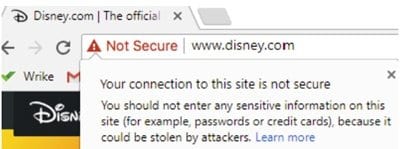 Anytime you surf the web, you put your sensitive data and personal information at risk. In a recent HubSpot Consumer Survey, 82% of U.S. respondents said they would leave a site that is not secure.
Anytime you surf the web, you put your sensitive data and personal information at risk. In a recent HubSpot Consumer Survey, 82% of U.S. respondents said they would leave a site that is not secure.
While the personal information of their visitors and users is vulnerable, many businesses still don’t prioritize website security as much as they should.
The “Not Secure” Warning
What to Know About Google’s Chrome Security Update
Google has been driving the push to increase web security for over a year now. In one of Google’s recent Chrome updates, they began flagging pages and sites as “Not Secure” right inside a user’s browser.

The bright red text fires a clear warning to users when a website’s security is not up to snuff.
This change does help protect user’s privacy and information, but it should also be a big wake up call to businesses who haven’t taken website security seriously.
This particular version of Chrome warns users of pages and sites that include a form but don’t have a basic security layer called SSL (Secure Sockets Layer). SSL ensures all information that is transferred between a server and a browser, such as credit cards, passwords, and other data, remains private and protected against hackers.
Citing the HubSpot statistic from above, if your business’s website doesn’t have SSL security, then 8 out of 10 Chrome users would leave your website.
Check If Your Website Has SSL
Given the added protection and improved ranking opportunities for your site, you know by now how beneficial it is to enable SSL security, but how do you tell if your site already has it?
Complete the following steps to determine if your website is protected with SSL:
- Enter your URL in the navigation bar
- Once there, check the full URL
- If the URL starts with “http://” – it is not secure
- If the URL starts with “https://” – it is secure
Optional: You can also plug a URL into the HubSpot SSL Checker to determine its security without visiting the actual site.
If your website is not secure, your SEO efforts and site traffic will suffer as a result.
How to Make Your Website More Secure with SSL
First, determine the type of SSL certificate you need and how many. If you host content on different domains or subdomains, you might need different certificates. SSL certifications can cost anywhere from free to a couple hundred dollars a month, with an average around $50 per month, per domain. (Note: some CMS providers, have SSL included).
Even if you already have SSL, that doesn’t mean you’ve done all you can. You can always do more to increase your website’s security:
- Update any plugins, apps or extensions on your site.
- Use a Content Delivery Network (CDN).
- Use a password manager. (At HeadsUp, we use LastPass.)
Final Thoughts
If you own or manage a website and want to make security a priority, you should enable an SSL certificate along with other security measures. Companies that don’t take the proper steps to secure visitor information risk significant security issues, garner bad publicity, and destroy customer trust.
Does your website have SSL security? Do you have any security tips you’d like to share? Let us know your ideas in the comments section, and contact us if you have any questions about how to make security a priority for your business.
